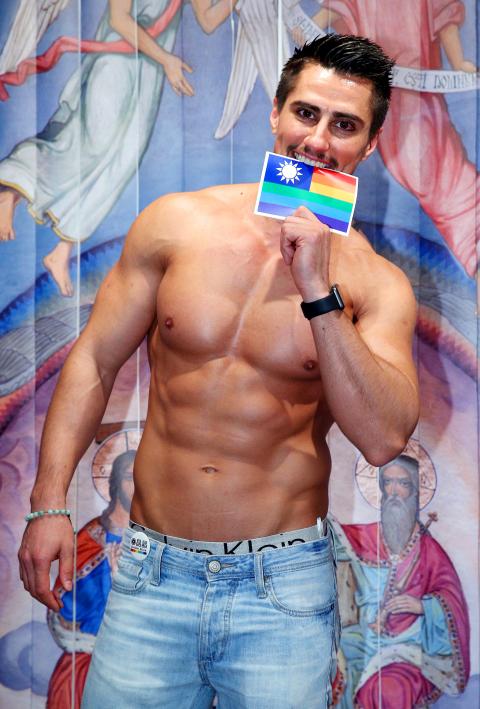Last month, over 80,000 lesbian, gay, bisexual and transgender (LGBT) people and their supporters marched in the 13th Taiwan LGBT Pride Parade (台灣同志遊行). Turnout was historic, as the parade has become the second largest LGBT event in Asia and the Middle East, after the Tel Aviv Gay Pride Parade.
A number of events were also held last month to celebrate LGBT pride, including the Taiwan International Queer Film Festival (台灣國際酷兒影展), the Hand in Hand Asian LGBT Choral Festival, which featured over 150 vocalists from around the world, and the ILGA-Asia Conference, the largest of its kind in Asia with 300 activists from over 30 countries.
In the past, most foreign participants were from neighboring countries. But this year, many hailed from the West. According to the Taiwan LGBT Pride (台灣同志遊行聯盟), organizer of the parade, over 5,000 foreign participants took part in the parade and related international events. And thanks to the foreign media’s coverage, the parade successfully boosted the global visibility of Taiwan’s LGBT community.

Photo: REUTERS
“The Taiwan LGBT Pride Parade is a famous international event. I want to be part of it to show support,” said Father Silas of the Romanian Orthodox Church during his visit to Taipei. Silas posed nude for the Orthodox Calendar this year to protest homophobia and show his support for the LGBT community.
Meanwhile, some presidential and legislative candidates promised to protect LGBT rights should they be elected.
OVERWHELMING SUPPORT

Photo: CNA
On the day of the parade, the Ministry of Justice completed the nation’s largest online vote to date on same-sex marriage, which will serve as a reference for policymaking. More than 310,000 people participated in the three-month vote, which was held between Aug. 3 and Oct. 31 on the government’s Public Policy Network Participation Platform (公共政策網路參與平台).
The poll revealed that 59 percent support legal protection for same-sex couples, 71 percent support a same-sex marriage act and 45 percent support a same-sex partnership act, where gay couples are offered certain rights enjoyed by married couples, instead of full marriage rights.
These figures clearly show that support for same-sex marriage has surged to a new high compared with a 2013 poll.
TIME TO ACT
For that poll, the ministry commissioned the Police Research Association (中華警政研究學會) to conduct a study on the feasibility of same-sex marriage legislation. The results showed that 53.7 percent of respondents agreed that same-sex couples should be allowed to marry, and 61.1 percent said that married same-sex couples should be allowed to adopt children.
In response, the association recommended that the ministry push for marriage equality legislation.
However, when the legislature commenced discussion of the draft bill for marriage equality last year, not only did the ministry ignore the association’s recommendations, it also called same-sex marriage “an ethical violation of human relations” in its report to the legislature.
With the results of this new poll showing support for marriage equality increasing from 53.7 percent to 71 percent within a few years, will the ministry continue to groundlessly criticize it while ignoring public opinion?
Some politicians and officials claim that Taiwanese are not ready for same-sex marriage. But the results of the ministry’s own polls clearly show that the majority of Taiwanese are. It’s about time our politicians faced up to this reality.

Seven hundred job applications. One interview. Marco Mascaro arrived in Taiwan last year with a PhD in engineering physics and years of experience at a European research center. He thought his Gold Card would guarantee him a foothold in Taiwan’s job market. “It’s marketed as if Taiwan really needs you,” the 33-year-old Italian says. “The reality is that companies here don’t really need us.” The Employment Gold Card was designed to fix Taiwan’s labor shortage by offering foreign professionals a combined resident visa and open work permit valid for three years. But for many, like Mascaro, the welcome mat ends at the door. A

Divadlo feels like your warm neighborhood slice of home — even if you’ve only ever spent a few days in Prague, like myself. A projector is screening retro animations by Czech director Karel Zeman, the shelves are lined with books and vinyl, and the owner will sit with you to share stories over a glass of pear brandy. The food is also fantastic, not just a new cultural experience but filled with nostalgia, recipes from home and laden with soul-warming carbs, perfect as the weather turns chilly. A Prague native, Kaio Picha has been in Taipei for 13 years and

The Western media once again enthusiastically forwarded Beijing’s talking points on Japanese Prime Minister Sanae Takaichi’s comment two weeks ago that an attack by the People’s Republic of China (PRC) on Taiwan was an existential threat to Japan and would trigger Japanese military intervention in defense of Taiwan. The predictable reach for clickbait meant that a string of teachable moments was lost, “like tears in the rain.” Again. The Economist led the way, assigning the blame to the victim. “Takaichi Sanae was bound to rile China sooner rather than later,” the magazine asserted. It then explained: “Japan’s new prime minister is

Since Cheng Li-wun (鄭麗文) was elected Chinese Nationalist Party (KMT) chair on Oct. 18, she has become a polarizing figure. Her supporters see her as a firebrand critic of the ruling Democratic Progressive Party (DPP), while others, including some in her own party, have charged that she is Chinese President Xi Jinping’s (習近平) preferred candidate and that her election was possibly supported by the Chinese Communist Party’s (CPP) unit for political warfare and international influence, the “united front.” Indeed, Xi quickly congratulated Cheng upon her election. The 55-year-old former lawmaker and ex-talk show host, who was sworn in on Nov.